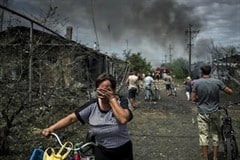
Russia and the West are at war – over fruits, veggies, pork, and bank loans. The cause is Ukraine, a vast emptiness formerly unknown to the western world, but now deemed a vital national security interest worthy of a risking a very scary war.
Economic embargos such as those launched by the US against Russia may seem relatively harmless. They are not. Trade sanctions are a form of strategic warfare that is sometimes followed by bullets and shells.
Think, for good example, of the 1940 US embargo against Japan that led Tokyo’s fateful decision to go to war rather than face slow, economic strangulation. How many Americans know that President Roosevelt closed the Panama Canal to Japanese shipping to enforce demands that Tokyo get out of Manchuria and China?
Frighteningly, today, there are senior officials in Washington and Moscow who are actually considering a head on clash in Ukraine between Russian forces and NATO – which is an extension of US military power.
Intensifying attacks by Ukrainian government forces (quietly armed and financed by the US) against pro-Russian separatists and civilian targets in eastern Ukraine are increasing the danger that Moscow may intervene militarily to protect Ukraine’s ethnic Russian minority.
A full-scale military clash could begin with a Russian-declared “no-fly” zone over the eastern Ukraine such as the US imposed over Iraq. Moscow’s aim would be to stop the bombing and shelling of Ukrainian rebel cities by Kiev’s air force.
Russia’s leader, President Vladimir Putin, is under growing popular pressure to stop the killing of pro-Russian Ukrainians – who were Russian citizens until 1991.
The US just launched air strikes against northern Iraq, ostensibly to protect Yazidis, a small religious cult based on Zoroastrianism, which many Iraqis call devil worshipers. Though these strikes were clearly aimed at bolstering US-backed Kurds against the advancing Islamic State forces, Washington called them a humanitarian attack to protect Iraqi Christians and Yazidis – perfectly in keeping with the administration’s claim to be waging humanitarian warfare.
NATO could quickly deploy its potent air power against Russian aircraft. US and NATO aircraft flying from new bases in Romania, Bulgaria, and Poland could seriously challenge the Russian Air Force over the Russia-Ukraine border region. More US warplanes would be rushed into Eastern Europe. Russian air defenses are strong and its air bases are close to the sphere of action. Still, NATO air power has a technological superiority over the Russian Air Force and better trained pilots.
On the ground, Russia has a slight advantage. It has 16,000-18,000 troops on the Ukraine border made up of mechanized infantry, armor, mobile air defense and artillery. A competent but small force, and hardly a menace to Europe, as the pro-war media howl. Compare this small number of troops to the Soviet 1st Ukrainian Front alone in 1944, made up of six armies and thousands of tanks and heavy guns.
Russia could fight border skirmishes but certainly not retake Ukraine with this paltry force. Russia’s once 200-division army which boasted some 50,000 tanks is today a shadow of its past: 205,000 active soldiers and 80,000 indifferent reservists spread over the world’s largest nation. Russia, as always, has excellent heavy artillery and good tanks, but nothing compared to WWII when Soviet 152mm guns and rocket batteries were lined up wheel-to-wheel for kilometers.
Any attempt by NATO to capture Crimea would likely be defeated by Soviet air, naval, and land forces. The constricted, shallow Black Sea could prove a death trap for US warships. Sevastopol (with Leningrad and Stalingrad) was named a Hero City of the Soviet Union for its heroic defense in WWII
Ukraine’s cobbled together army, about 64,000 men, suffers from poor training, logistical problems, and weak leadership. During Soviet days, it numbered more than 700,000 with the cutting edge of Russian weapons. Today, the army is stiffened by foreign mercenaries and far-rightists from Kiev. Even so, it could not stand up to Russia’s better-armed, better-equipped troops.
What about NATO? In 1970, the US Army had about 710,000 soldiers in Europe, mostly based in Germany. Today, US has only 27,500 German-based troops left, largely non-combat support units. At best, the US could probably assemble two weak combat brigades – about 5,500 men total – to rush to Ukraine. The rest of US forces are based in Afghanistan, Kuwait, the Gulf, South Korea, and Japan, or at stateside. Moving them to Europe would take about six months.
But the US still retains large airbases in Germany that could support military intervention in Ukraine. Lately, small US and NATO contingents have been quietly inserted into East Europe and the Baltic region – large enough to spark a war, but too small to win one.
Since the end of the Cold War, the US armed forces, NATO, and Russia’s military have been sharply reduced by budget cuts. Until the Ukraine crisis, there was almost no prospect of war in Europe. Ardor for war among Europeans and Russians is very low.
Britain, now a toothless old lion, would support the US in Ukraine with a few men and warplanes; so would France, Denmark, Poland, Canada, and Holland, but to a limited or even token degree. Germany and Turkey, NATO’s two heavy hitters, want to avoid any conflict with Russia and might well stand aside. They both do very large business with Russia and are unhappy about the manufactured Ukraine crisis.
So any military clash in Ukraine would initially be limited in scope and intensity. But a confrontation could quickly escalate into a dangerous crisis. The Cold War taught that nuclear–armed powers must never fight directly, only through proxies.
Nothing is worth the risk of nuclear war, even a limited one.
Let the Ukrainians sort out their differences by referendum.
On the 100th anniversary of World War I, we again see our leaders playing with matches.
Reprinted with author’s permission from his website.
